Thierry J.-L. Courvoisier, April 2024
Photos by B. Courvoisier unless explicitly mentioned otherwise
Gaia spent the austral Winter of 2023 in Piriapolis, Uruguay, well looked after by Victor, our local contact. It is there that we met Omar Sanchez, the OCC port officer for Buenos Aires, in April 2023 for the first time. Omar had recommended Piriapolis as the best place to leave Gaia and suggested that we visit Buenos Aires when returning from Switzerland before going on board. This we did and enjoyed a highly interesting and vivid visit of the city thanks to his deep knowledge of the city, its monuments, its life and its history. When we had mentioned that we would be happy to sail around South America via the Beagle channel with friends rather than just Barbara and I, Omar had expressed his interest in joining us, and mentioned that he had already sailed that route all the way to Puerto Natales. Knowing that his presence on board would not only be a precious help but also pleasant, arrangements were made accordingly. Ivo Herzog, a Brazilian friend met in Itajai the previous year was to be the fourth on board. We decided to be ready to sail south from Mar del Plata on November 15.
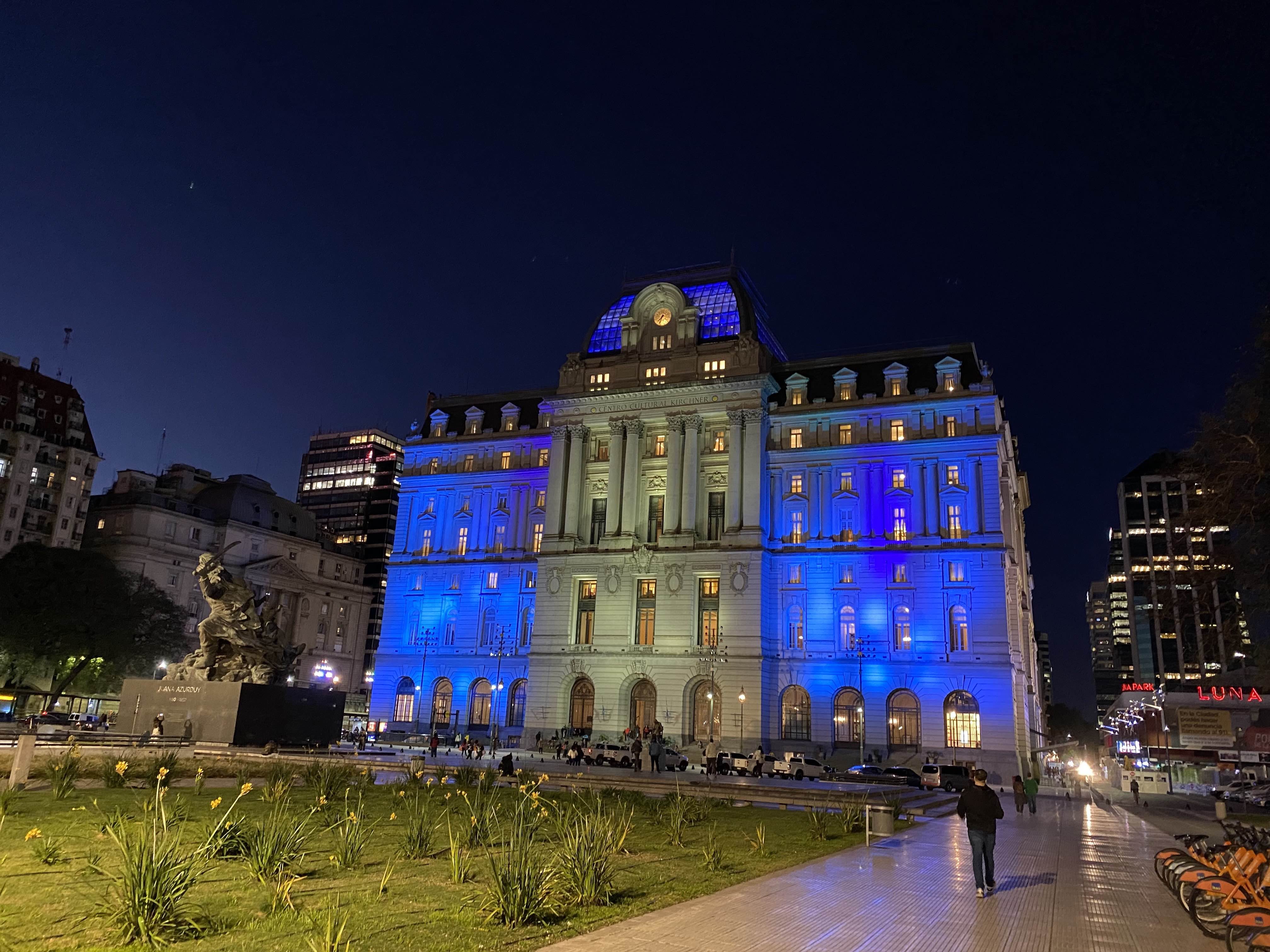
Post hotel Buenos Aires
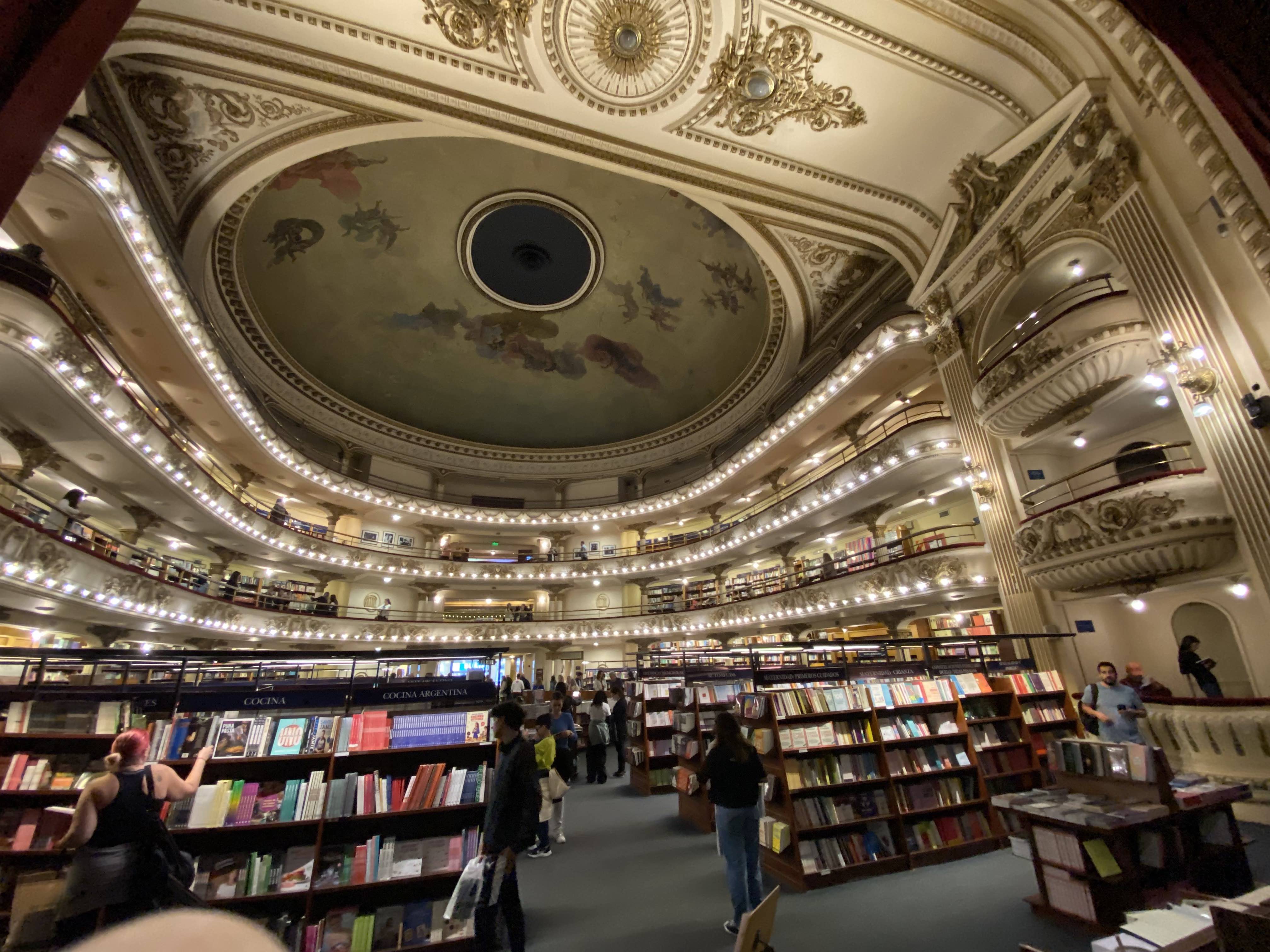
El Atenao, bookshop in Buenos Aires
Tango in Buenos Aires
Mar del Plata is home to a lively sailing community with two sailing clubs, the Yacht Club Argentino and the Club Nautico Mar del Plata. Children and teenagers train and race in and out of the protected harbour also in strong winds. It is also there that the Sirio, the last boat of Argentinian solo circumnavigator Vito Dumas is moored. It is also a city where we found a number of new and very helpful friends.
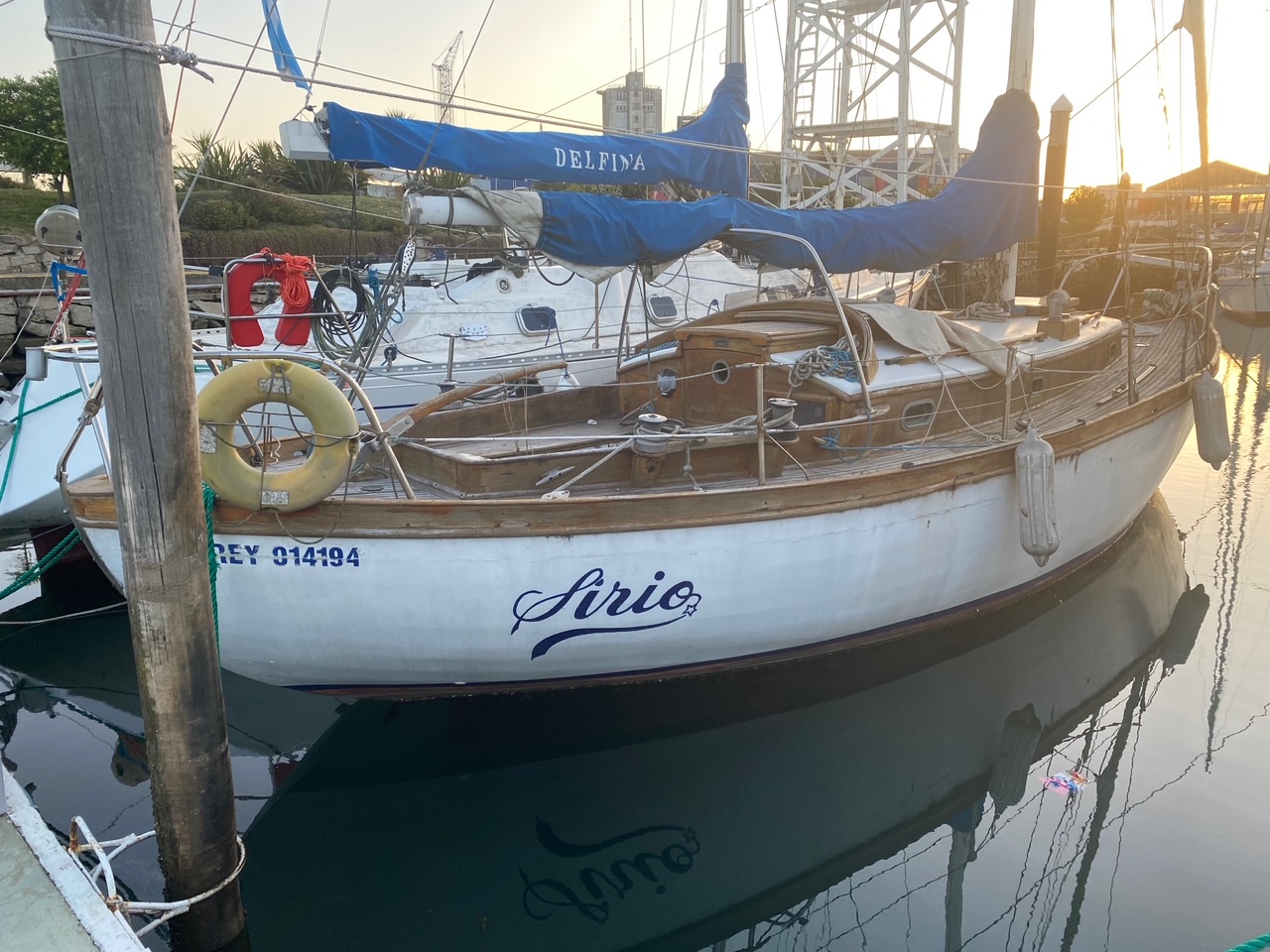
Sirio, the last boat of Vito Dumas moored in Mar del Plata

Gaia’s crew to Puerto Natales: Barbara, Thierry, Omar Sanchez OCC port officer and Ivo Herzog
We left Mar del Plata after a spell of poor weather on November 22 at the midnight high tide having purchased the equipment needed in Patagonian anchorages (four 100m lines, a machete and fishing boots), bunkered, provisioned and fulfilled the requirements of the Armada. Our first port of call would depend on the weather and conditions met en route. Those being good we skipped a stop in Puerto Madryn, where the anchorage has a poor reputation, and continued in the direction of Caleta Horno. After a night in an anchorage to let a South wind blow itself out we reached the caleta, a barren rocky inlet in a deserted environment. The depths being rather less than chartered we tied at the entrance using the anchor and four lines to the shore, two on each side of the caleta, in a magnificent weather. This was to change drastically a day later. A North blow lasting a day and a night hit us with 50kt. The caleta was oriented so that the north wind blew straight down between the steep shores and onto our stern. The two stern lines took all the tension: a full scale stress test for the lines bought in Mar del Plata. It was also a test for the nervous system of the crew. Lines, boat and crew passed the test with flying colours. We only had to sew part of the cockpit cloth protection.

Gaia with four shore lines in Caleta Horno
Deseado was our next stop. Mooring facilities are very limited there, one single berth being reasonably protected behind a floating pontoon of the local shipyard in barely enough water. While in Deseado Eugénie Nottebom, OCC member on board Giulia, announced on a whatsapp group of sailors to Patagonia that she intended to sail south alone on her Contessa 32 from San Julian, some 100 NM south of Deseado, and would be keen to know of other sailors intending to be in the same waters at the same time. The route lies along the Argentinian coast through the Lemaire straight and into the Beagle Channel. These are not the kindest waters of the planet, particularly for a single sailor on a small vessel. Since our intentions were very similar in terms of route and timescale we kept in touch as we left Deseado, first via satellite e-mail, then through VHF and finally with direct eye contact as we approached the Lemaire straight. It is no problem to sail through the straight in mild conditions, it is however very dangerous when the conditions are not optimal. We had therefore planned on a stop at the Staten islands off the Tierra del Fuego to wait for a suitable weather. It became clear, though, as we approached that we could sail the straight when we arrived provided that we waited some hours for the tide to reverse and flow south. This we did together with Eugénie in the early hours of December 11. The current never reversed, but it did decrease to some 1.5-2kt flowing north. The wind picked up from the predicted calm to some 20kt from the North. This resulted in a steep 1-2m sea, quite OK, but enough to imagine that the place can be as dreadful as described in the literature. A large but reasonably sheltered bay some distance from the straight, Puerto Espanol, offered a welcome anchorage for Giulia and Gaia for a warm meal, a non negligible amount of wine and a quiet night, all needed to let the adrenaline level decrease in our blood.

Bad weather on the Atlantic
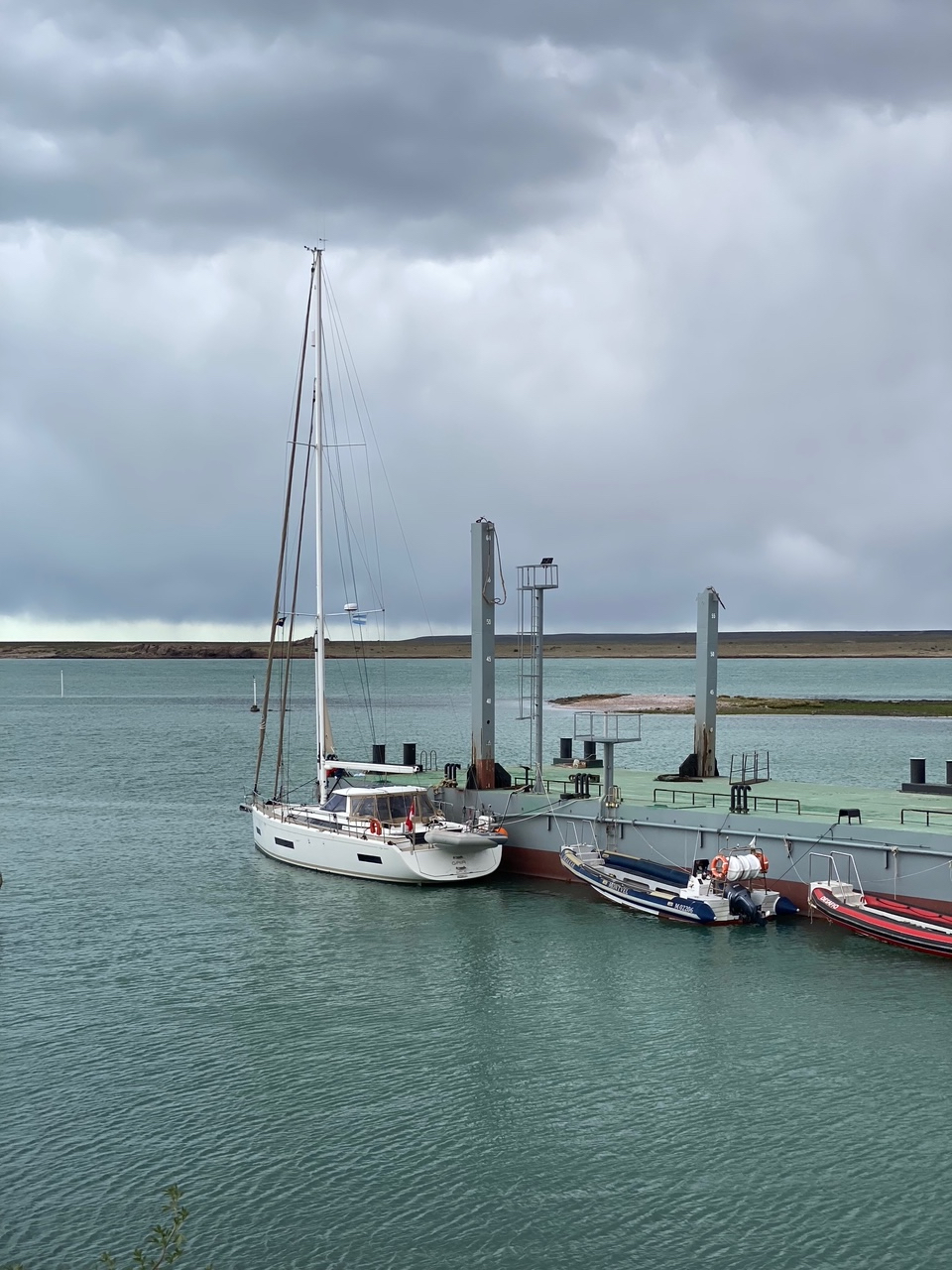
The one protected berth in Puerto Deseado
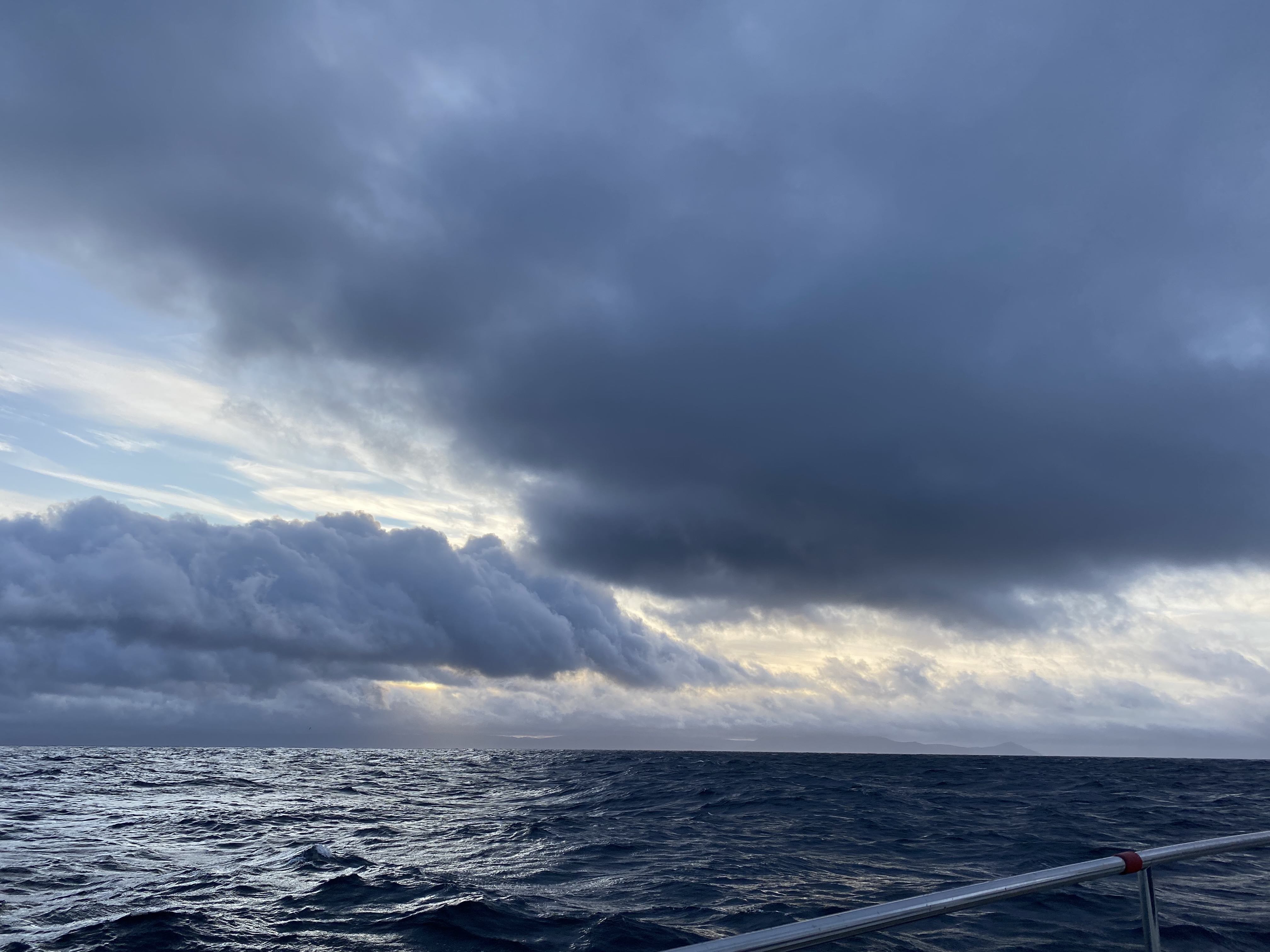
The Lemaire straight in the early hours of December 11
The Beagle channel was quiet, even sunny, the following days, allowing for a smooth trip to Ushuaia including a stop in Harberton Farm and one in Puerto Almanza where a small restaurant offers splendid centollas.
The facilities in Ushuaia are rather minimal. A wooden pier at the AFASyN, the club nautico, is managed by Roxana Diaz, OCC port officer, with a competent and somewhat authoritarian approach. An attitude needed to organise the coming and going of a number of rather large charter sailboats en route to and from Antarctica. The club opens a warm room to the sailing community where we spent the Christmas and New Year’s eves. There is also an old fishing boat, Angel B, open only to club members but where we spent a wonderful evening thanks to the local relations of Omar. The wind blows with severity in Ushuaia, thankfully from a direction with little fetch at the AFASyN pier. A reminder that the Beagle channel is not always as calm as on our arrival and a warning for the coming weeks. Barbara hurt herself cutting vegetables, a sound reminder that vegetables are not as healthy as some would like us to think. Omar, a cardiologist, showed his broad medical competence in curing the wound using mainly sugar, a well known war medecine technique.
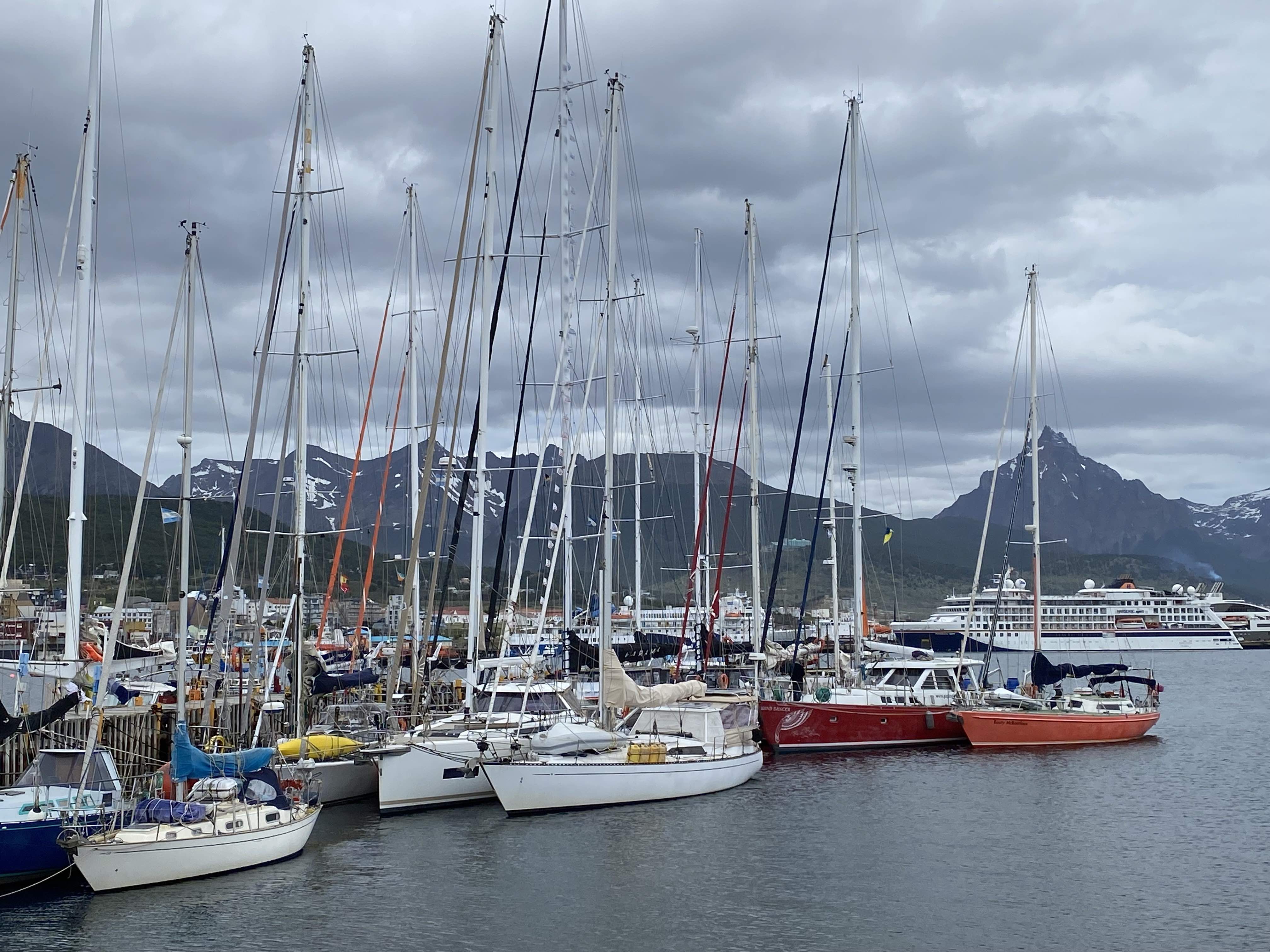
The AFAsYN pier in Ushuaia
The way Argentina and Chili share the southern tip of America and the tension between the two states imply that one has to sail 25NM back, i.e. west, from Ushuaia to Puerto Williams to enter Chili. Leaving Ushuaia requires obtaining an authorisation from the capitania, the port authorities. This comes with the possible visit of an official to check the equipment of the vessel. While some of the requirements are reasonable and some staff informed, these visits can be somewhat kafkaein. A bell and an axe are for example required, meaningless pieces of equipment on a modern sailing boat, a fact of no relevance in the eyes of some officials in regard to the fact that they are on the list of mandatory equipment. A visit having been announced on Gaia, we borrowed an axe from a neighbouring boat. The visit being at dinner time it was dealt with swiftly without hassle.
Puerto Williams has no harbour but a well sheltered cove in which the Micalvi, an old transport cargo ship, is run on ground. The first come tie to the Micalvi, the next ones on a second layer and up to four or five layers. The Micalvi serves as a club house and is home to a semi infinite number of drinks and parties, including a birthday party for Camilla on board Songster (OCC) with Jurriaan and their son Christopher, two years old. The Chilian rules prohibit the import of fresh food. The custom officials in charge of enforcing this rule thus prefer to do the paperwork on the Micalvi, avoiding to see the few apples and the like that crews may have on board. The armada and the immigration have to be visited on shore. The whole exercise is lengthy but friendly.
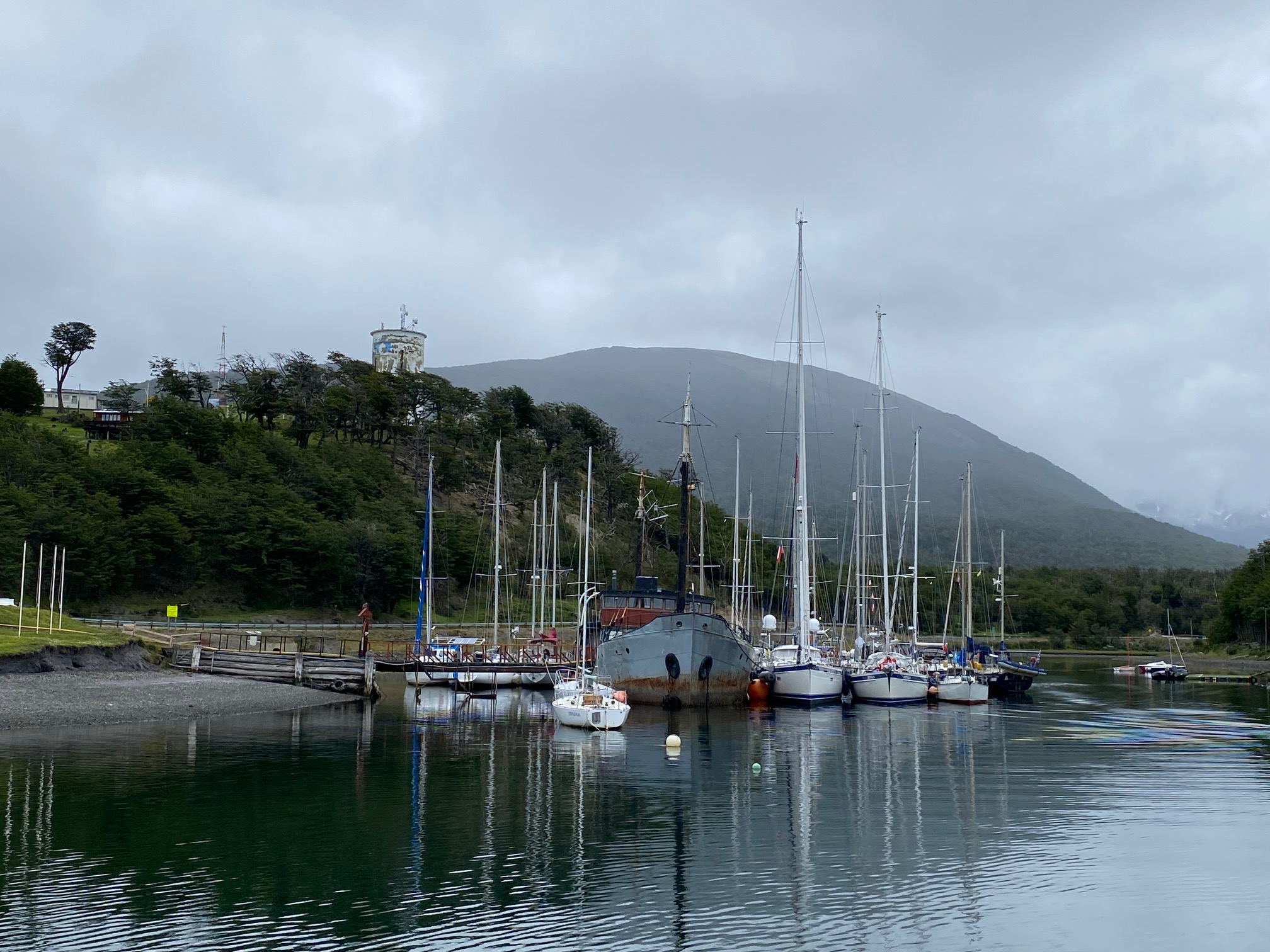
Mooring alongside the Micalvi in Puerto Williams
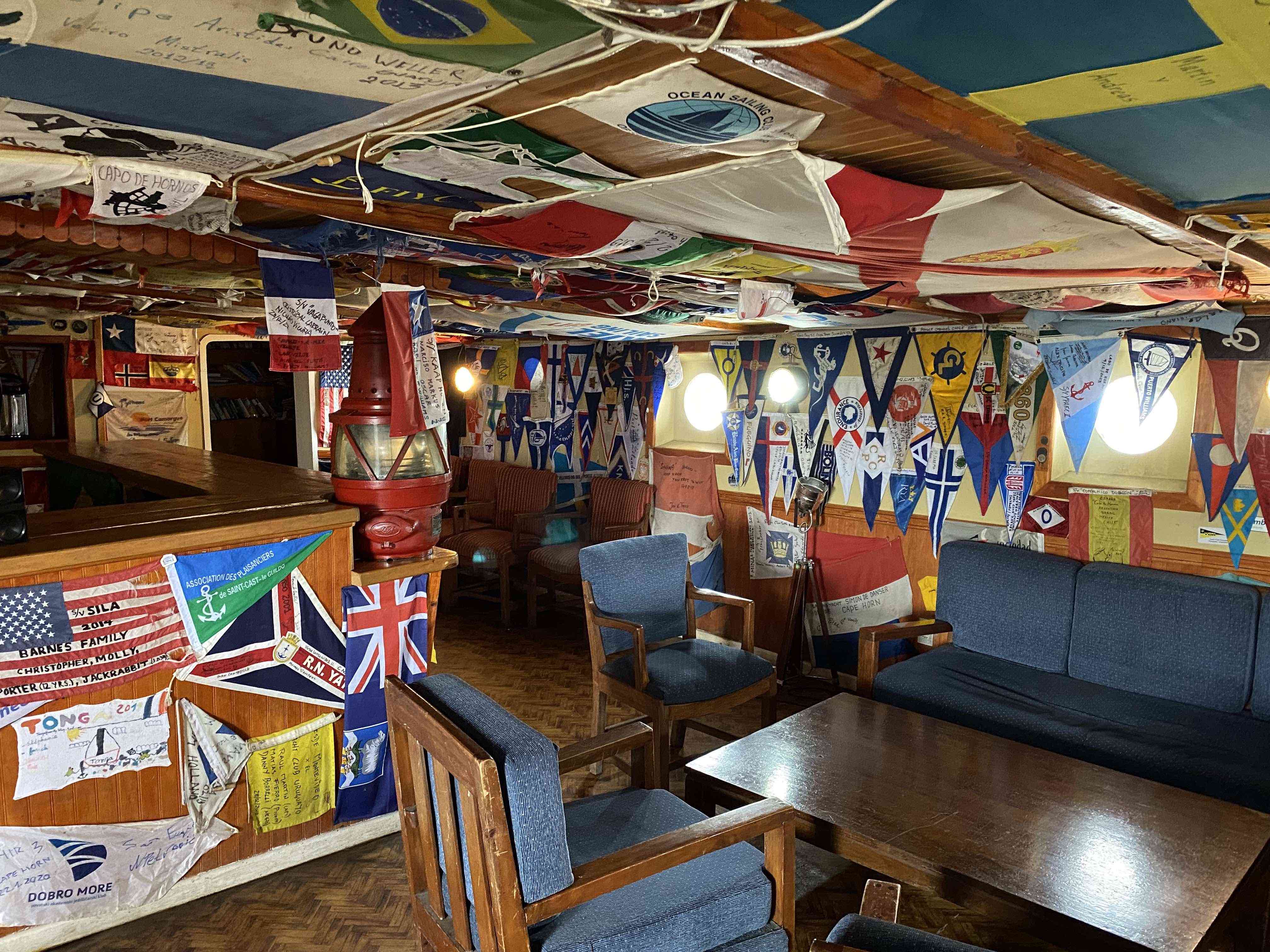
Inside the Micalvi in Puerto Williams
Leaving Puerto Williams to sail North in the Patagonian channels means saying good bye to human civilisation for quite some time: the next harbour, Puerto Natales, lies some 500NM away. No road, no house, with the exception of two armada radio stations, no shop, no nothing, as some would say, on the way. Sailing these waters also means accepting a rather miserable weather. The orography of the region is such that the humid westerlies hit the continent, are lifted by the Andes and cool. The humidity condensates and rains down on the sailors who attempt to edge their way north. The winds are strong, we are in the hurling fifties, and funneled quasi always from the north between the innumerable islands. The water is entrained by the wind at speeds up to 2-4kt. The result is a cruise against winds not seldom 30kt and more in heavy rain at speeds over ground that are often as low as 2-3kt. Matters are made complicated by the fact that the weather forecasts don’t model the complex orography very well. The wind is thus more often than not considerably stronger in the channels than predicted by the models. While we did meet harsh conditions for most of the time, some sailors say that the weather they encountered was not as bad as what we experienced.
The Beagle channel runs south of the island Tierra del Fuego. On its west side the route turns north in a number of channels with an occasional opening to the Pacific Ocean. At some point these channels meet Magellan straight that follows the North side of the island and separates it from the continent. The Magellan straight follows a south west direction coming from the Atlantic to Cabo Froward and north west from there to the Pacific. The 120NM stretch of water from Cabo Froward to the Pacific is some 3-5NM wide and 1000m deep. The wind is always parallel to the straight, always against those who boldly attempt to sail north and mostly very strong. Sailing this stretch felt like a punishment. Coming out from the King Charles (not the UK one) island, a cargo ship called us on the VHF announcing 60kt winds some miles ahead. Needless to say that we pulled in the closest caleta. Several days later having sailed a few short spells and spent four days in a lone rainy caleta, Caleta Moystin, we sailed the last 30NM of the straight tacking n times in 25-30kt winds. When we reached the point where we could turn North again, at Isla Tamar, the wind which had been expected to decreased to 15-20kt increased to 35kt. This was a long day to reach Puerto Profundo at the entrance of canal Smyth where we waited for another storm to blow itself out before making some progress again towards Puerto Natales.
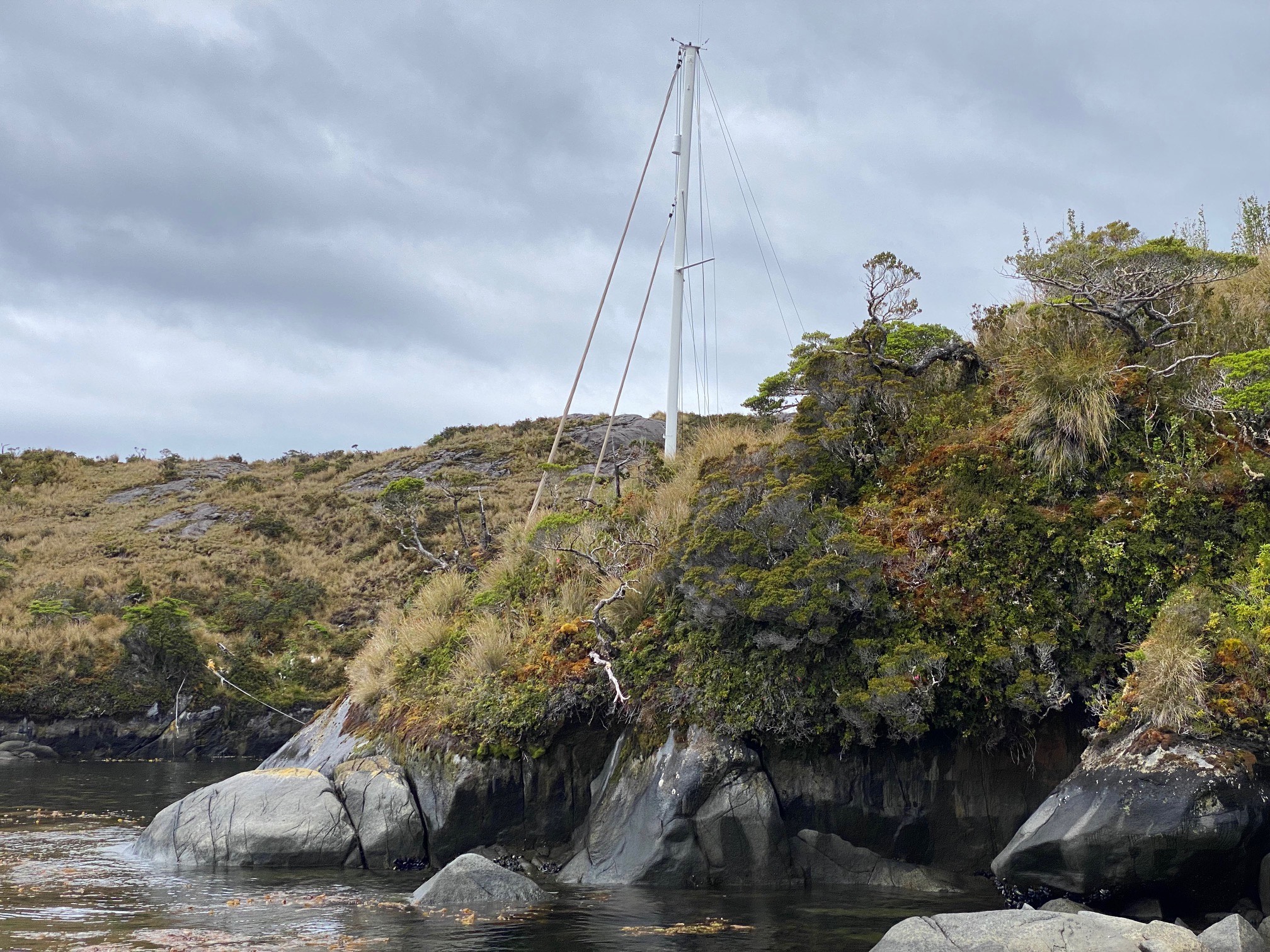
Gaia moored in Puerto Profundo
The caletas between Puerto Williams and Puerto Natales are often encumbered by large quantities of Kelp. Chain and anchor collect the long stems and leaves in heavy bundles that need be cut when the anchor is lifted, considerably complicating the departure manoeuvres, particularly in windy conditions in narrow anchorages. Hence the need for a strong machete and an energetic crew at the bow when lifting anchor.
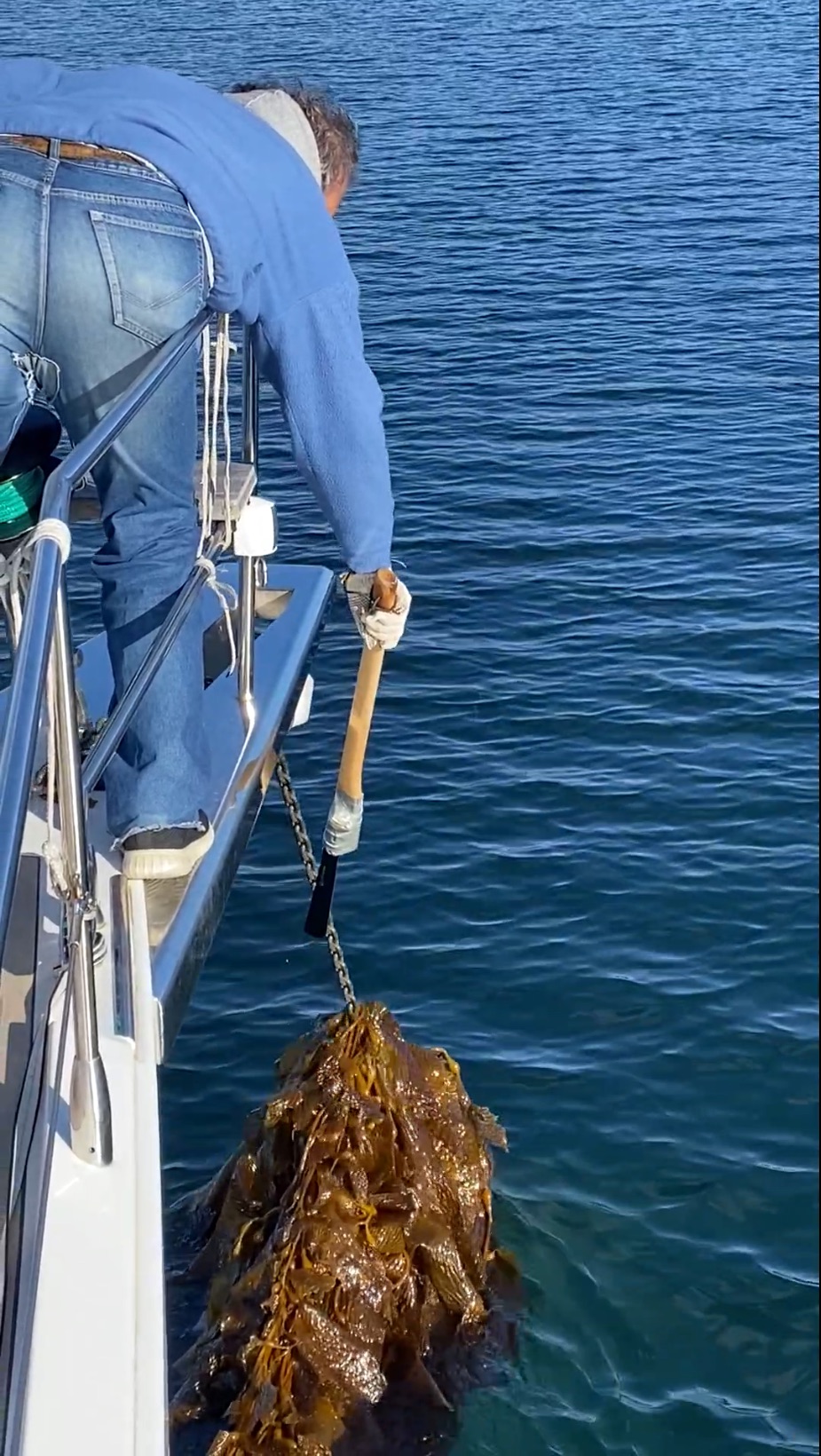
Omar cutting kelp while lifting anchor
We had left Puerto Williams January 7 2024 and reached Puerto Natales February 2. While the conditions were hard, the landscape was stunning in its sheer magnitude and isolation. Rocks and impenetrable forests for days on end. No paths to hike or stroll, seldom a gravel beach for a few steps, a powerful nature as it has existed since the last ice age. Rocks, mountains, trees, water, clouds and wind are the elements and the only elements of the landscape for hundreds of nautical miles. Human presence has always been very scarce in this region, no traces are left from any population. The crew of the few sailing boats in these waters experience the Earth as it exists devoid of human artifacts or signatures. The resulting feeling is very far from any experience modern inhabitants of civilised regions may have had. We stopped in a number of caletas, most of the time with anchor and shore lines, greatly helped by Omar with his previous experience and Ivo. In most caletas the protection from the wind is excellent but in some it blew up to 50kt, the feared williwaws. In some we had to stay several days, waiting for a relatively calm day. Our crew of four was a human island in a humanless universe. Time was spent in many lively discussions nourished by the vast knowledge of both Omar and Ivo on the South American recent history. Their insights help understand the reluctance of the large South American countries to endorse Anglo-Saxon geopolitical positions in the present context of shifting power equilibriums. Of a more immediate concern, there were at a point some questions as to whether we would have enough fuel and food as the speed of progress was low. We brought all the food forward and found out that we were fine regarding food, water, but also wine, but we were short on beer. Fuel also proved sufficient to reach Puerto Natales.
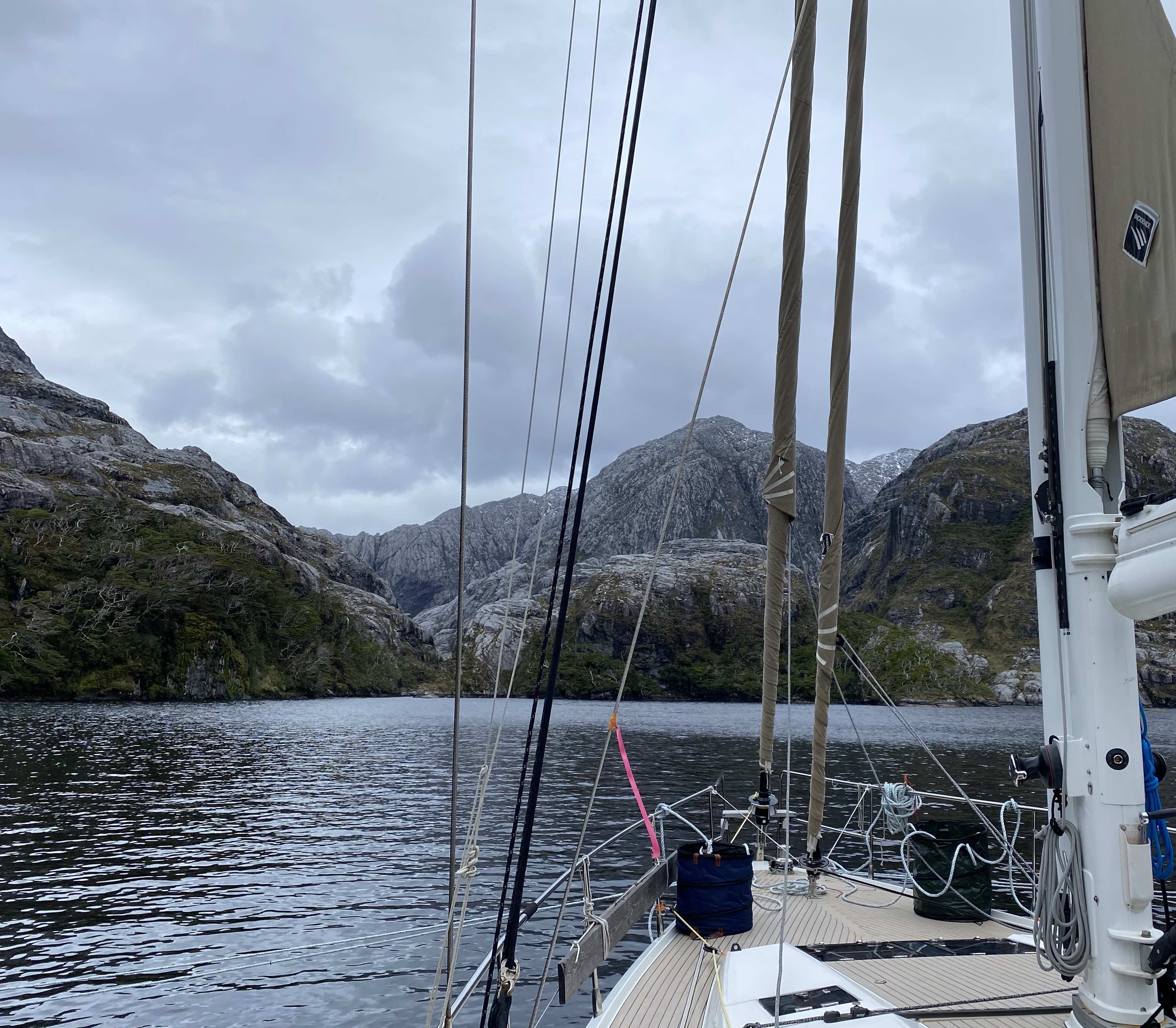
Moored in Caleta Brecknock

In Caleta Brecknock
Puerto Natales is a small city, the departure hub for many excursions to the nearby Torres del Peine, a large, wonderful and impressive mountain range some distance inland. The population in Summer is dominated by young and sporty tourists eager to hike and climb which provides for a lively city full of most welcome restaurants and shops. Puerto Natales is some way out of the direct route to the North and hence visited by very few boats. With few vessels en route in Patagonia anyway, the number of those stopping in Puerto Natales is negligibly small. Puerto Natales has the reputation of having few good berthing possibilities. One anchorage on the other side of the water expanse from the city lies about 1NM away, a crossing possible only with a dinghy considerably stronger than ours and in mild weather. We had foreseen a change of crew and had planned our food and fuel including refills there, we therefore went for the 100NM or so detour needed to visit the city. Nautical documentation mentioned that the fishing harbour was a place where a reasonably safe mooring alongside a fishing boat was available. We therefore approached that harbour and enquired by radio about the possibility to stay for a few days. This was refused repeatedly on the ground that the harbour was full. We learned later that the real reason for refusing sailing vessels is that there have been numerous issues of theft on the boats creating a big hassle for both sailors and harbour authorities. Sailing along the city we did not see any other place where it would be safe to stop and continued some 15NM where a safe anchorage, Puerto Pratt, can be found. We spent two days there. Ivo had rented a car, which greatly helped, but it was still impractical to fuel and bunker as a fence had to be climbed to reach the road from the boat. A fellow sailor had mentioned having stayed reasonably safe alongside a tug in the Skorpius commercial harbour. Not seeing any other plausible mooring we entered in dialogue with the harbour master who confirmed that we would be welcome for a price of 600 US$ per 24h. Thinking that this was ridiculous -also in view of the fact that no facilities were available- and assuming that discussions were bound to lead to a reasonable price, we went there and tied just before some nasty weather appeared. The discussions did not lead anywhere but to the threat of doubling the price. It proved impossible to speak directly with the contact that our friend had had. We were then left with no option other than to pay the amount requested. The weather was indeed nasty, the tug broke its lines one night and waves of one meter and more rocked us in whirling winds. In conclusion, Puerto Natales should be avoided if at all possible. The OCC port officer in Puerto Williams was informed of these difficulties and Omar sent the information to Noonsite. Omar and Ivo left us in Puerto Natales, while Paola, Mike and François, friends from Geneva, joined Gaia for the next weeks.

Gaia alongside the tug in Puerto Natales
Leaving Puerto Natales on February 9 was again a trial. The wind was predicted NW 15-20kt in the Golfo Almirante Montt just south of the city, it blew with 45kt. I was happy to have a boat capable of progressing and tacking in these conditions as we progressed west. Two days and one caleta later we reached Caleta Columbine where we found Songster with Camilla Jurriaan and Christopher and Boaty Mc Boatface, a German boat we had met in numerous occasions in the last six years. This was the beginning of, for the region, an intense social life. Few nights later, Amelia having joined, we were even four boats in Caleta Refugio picking ice from the sea to cool our drinks while dolphins swam around. Glaciers are indeed one element of the landscape. The Pie XI glacier is one of the most impressive ones, its front extends for almost two miles in the sea while it pushes its way through the forest. This glacier is one extremity of the continental ice shelf, one of the few, if not the only, glacier that grows at the present time on the planet.
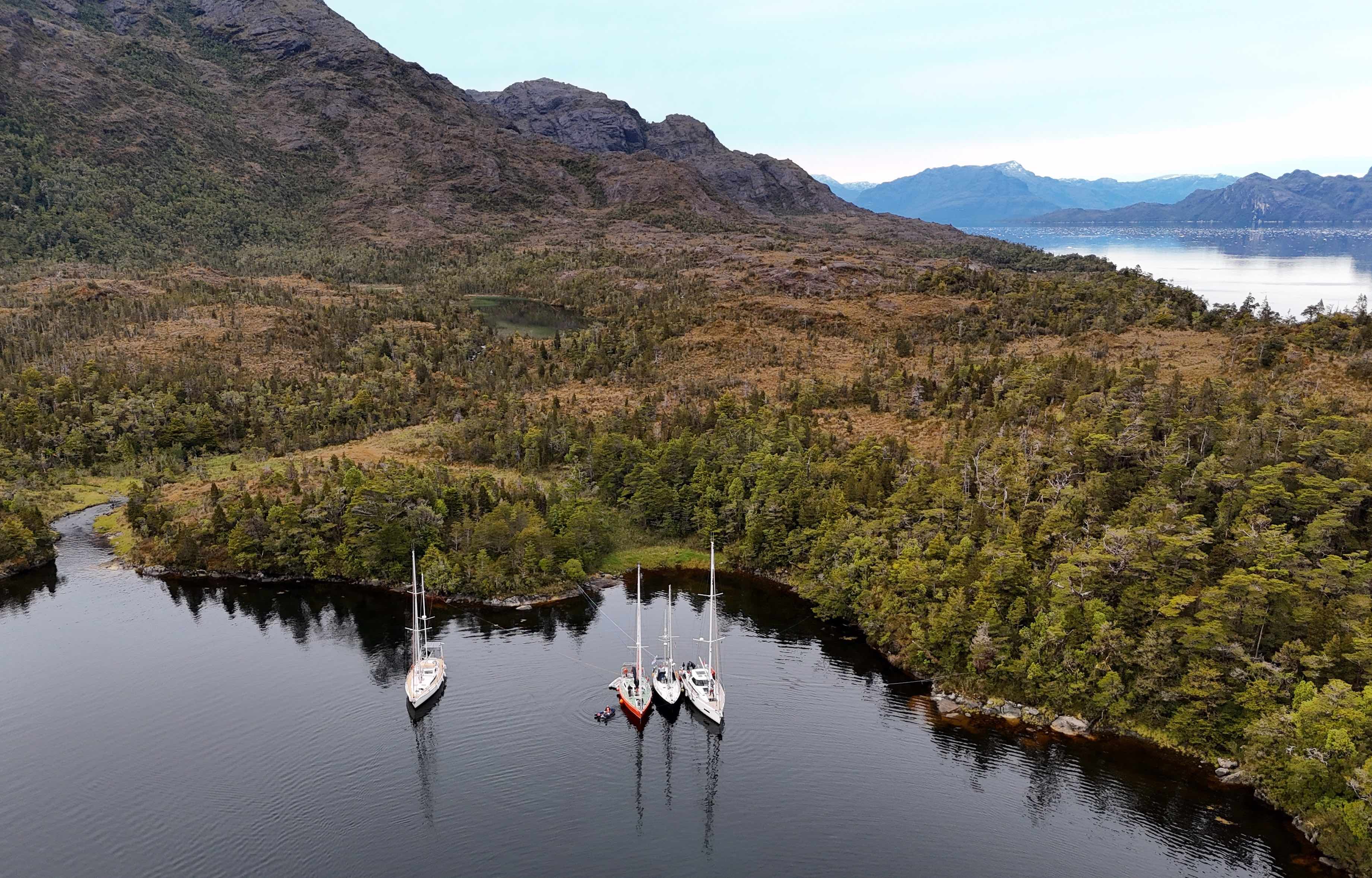
Four boats in Caleta Refugio: Amelia, Boaty McBoatface, Songster and Gaia
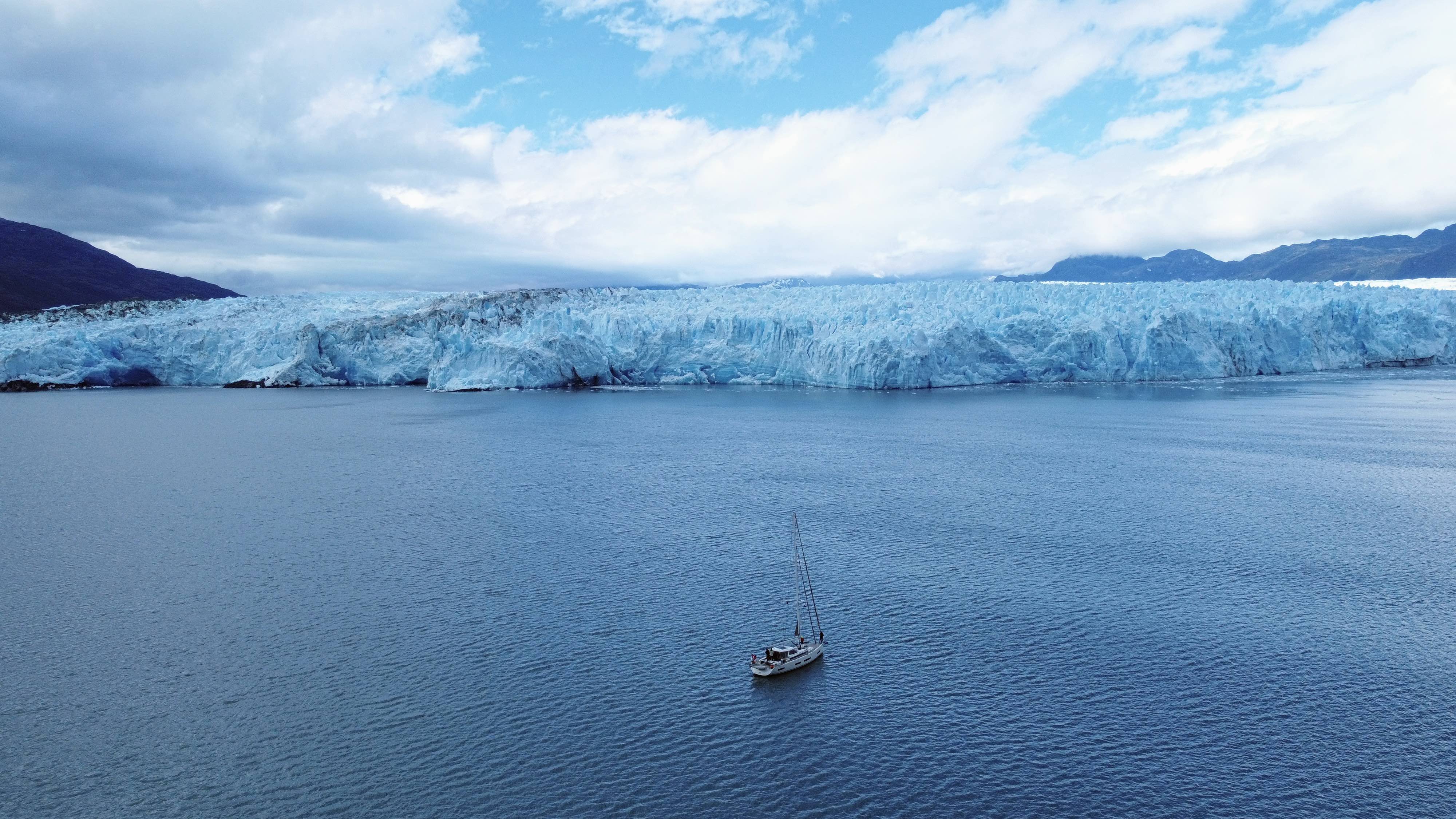 Pie XI, the front of the glacier (photo M. Struik)
Pie XI, the front of the glacier (photo M. Struik)
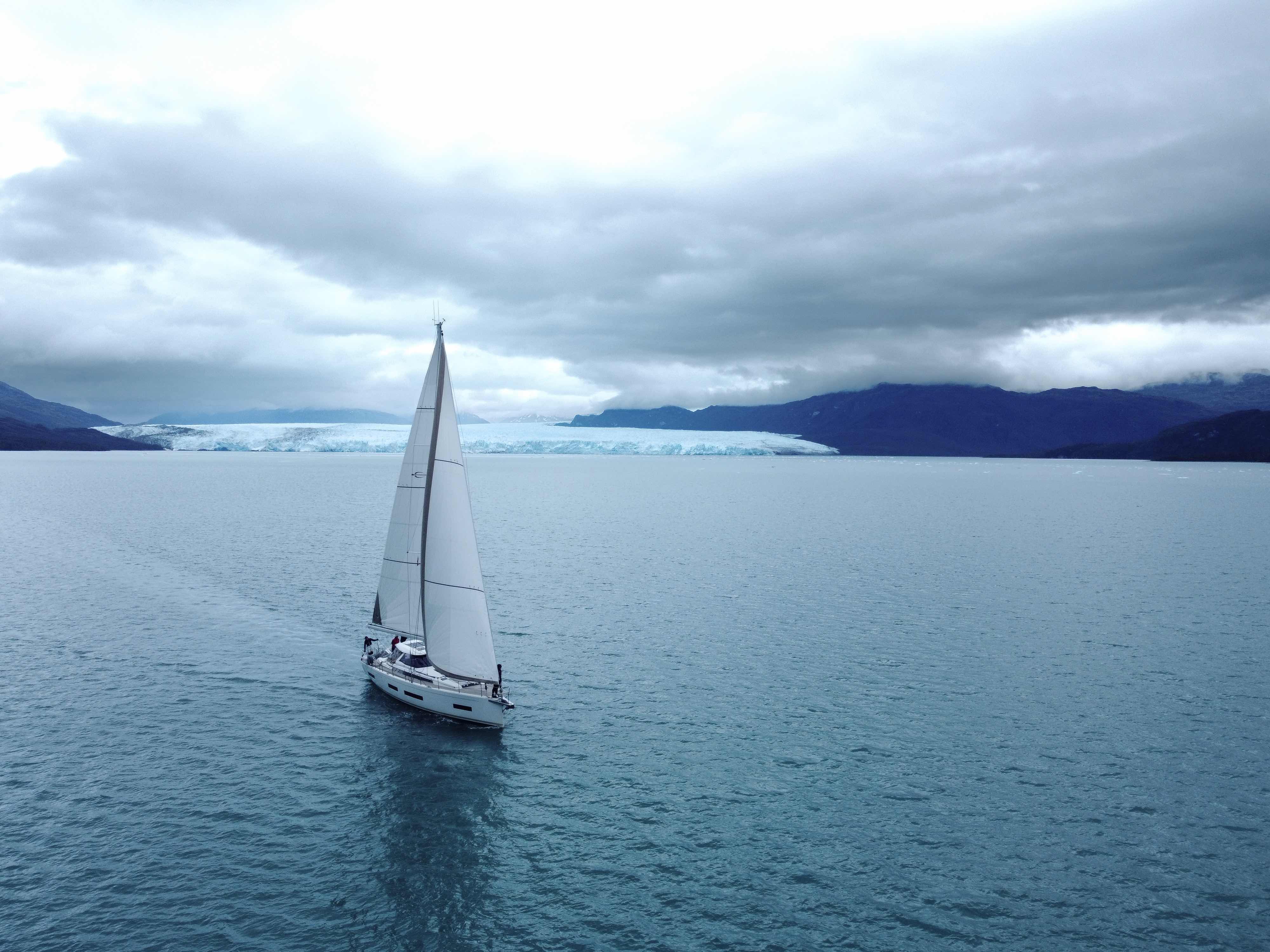
Leaving the glacier Pie XI in Seno Eyre (photo M. Struik)

Caleta Sally next to the Pie XI glacier (photo M. Struik)
 Caleta Lucrecia, en route to Puerto Eden
Caleta Lucrecia, en route to Puerto Eden
The glacier is two days from Puerto Eden, a lone village of now 50 inhabitants. The first settlement since Puerto Natales and, for those not stopping there, from Puerto Williams. The settlement exists because of a well sheltered bay. It was an early post of the armada close to which the local population, the Alakaluf, aggregated and lived for the last decades of their civilisation in the early 20th century. There were four boats there, Songster, Amelia, Boaty McBoatface and us. It was possible to have some laundry done, to buy some food the day after the passage of the cargo ship and to get fuel.

Puerto Eden
The route continues north of Puerto Eden along Messier’s channel (Messier was an astronomer who compiled a catalogue of fuzzy objects. the Andromeda galaxy, for example, bears the number 31 of this catalogue) to reach the golfo de Penas. A name that reflects the general feeling of those who sailed it. We enjoyed a rare spill of south west wind, fresh but from the right direction to sail the channel and the golf in one go. The golf was true to its reputation, irregularly, disagreably bumpy. The boat running fast in the fresh wind crashed loudly in the seas. not all stomachs could stand the ordeal as well as the hull. Arriving on the other side at Caleta Cliff, we had the surprise to find the chart position wrong by some two nautical miles but the waypoint given by the nautical guide was at the right position. Entering the pass to the caleta between high plumes of spray was thus sure to keep the skipper’s level of adrenaline high. The weather improved so much then that we unanimously decided for a day of rest. We repaired our staysail, explored the caleta on foot and by dinghy, some went for a short swim, and we enjoyed the sunshine.

Golfo de Penas
The route continues on the ocean to the Skyring peninsula where we spent a night in yet another spectacular caleta, Seno Pico Paika. A lone stone lies on the direct route in the middle of nothing. This stone, to be seen only because of the breaking seas, was also two nautical miles off the chart position. Amelia who was a day ahead of us had thankfully made us aware of the problem.
There are three paths to continue north from the Skyring peninsula, three possible channels. We chose the southernmost one to avoid some nasty north winds and went into Channel Pulluche which we entered in thick fog helped by the radar. Thankfully the chart was right again there. Few caletas later we reached Puerto Aguire where a floating pontoon is proudly called marina. The village is rather lively with 1200 inhabitants. Unfortunately, the establishment called “Ristorante de Navigantes” does not propose meals but the satisfaction of other needs of the flesh.
Few more caletas towards north brought us to Puerto Juan, some 40 NM south west of the island of Chiloe. A crossing we did under a blue and sunny sky with stunning views on the continental volcanos, Corcovado being the most impressive one covered as it is by scintillating snow and ice. We did not stop in Quellon, the southernmost city on Chiloe, of which we had not heard much positive, but in Estero Huidal, a nicely protected bay. There were cows grazing in the sun, some agriculture, Chiloe is home to large potato farming facilities. The contrast was vivid with the hostility of the landscape further south. Castro is the capital city of the island, a city where houses close to the shore are built on palafits, as the tides are up to eight meters in the area. For us this meant a pleasant stop in the marina Quinched, reasonably protected, not too far from the city and with friendly staff.
Fishing has not been particularly successful along the whole cruise, except once sailing along the shore of Chiloe when a sierra of respectable size bit on the bait prepared by François. It provided for two solid meals for the crews of Gaia and Amelia.
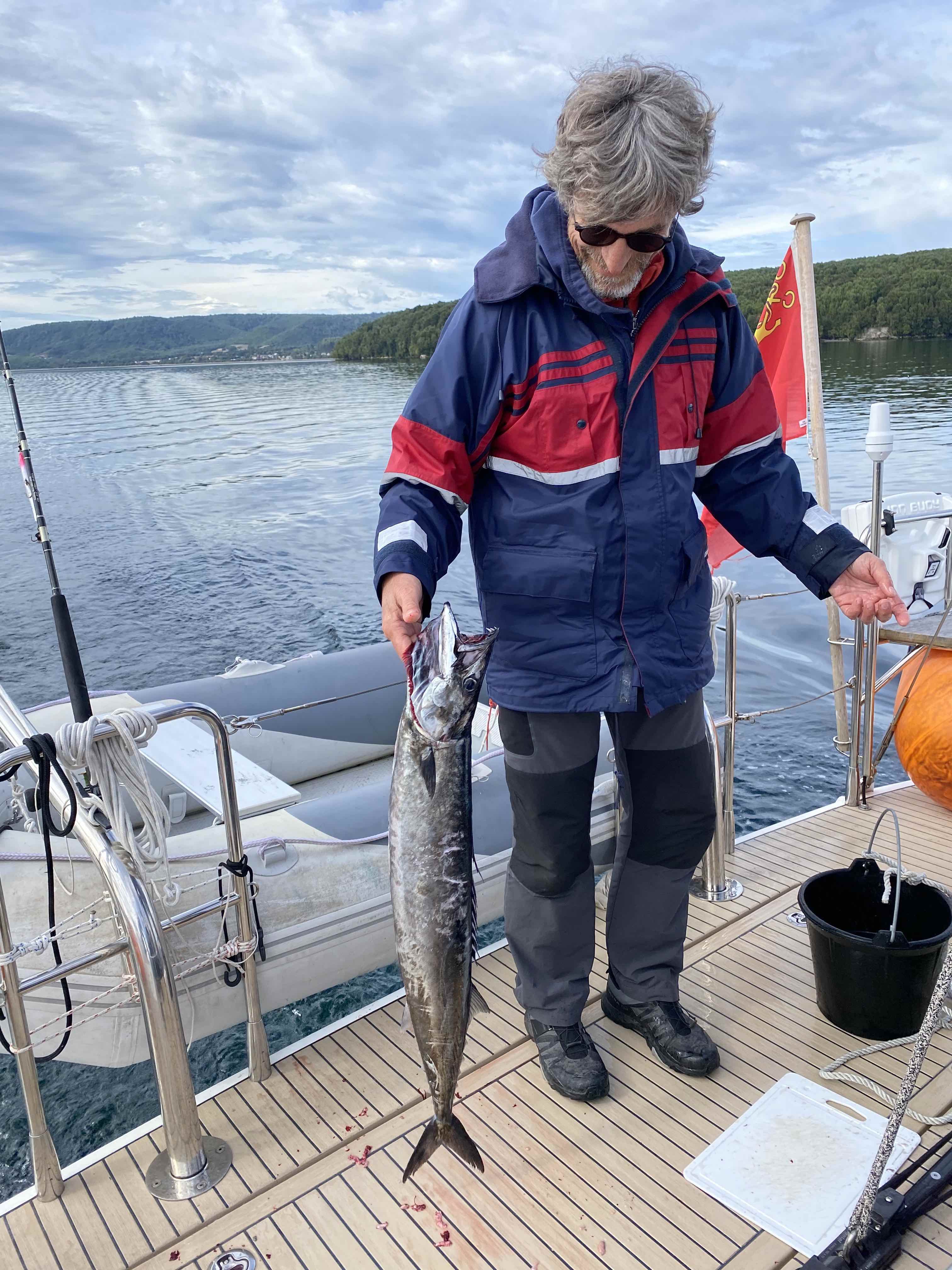
The one fish caught, a sierra, with the François, the fisherman on board.
The distance to Puerto Montt from there is about 70NM, time for another few caletas where the tide amplitude is the difficulty. Anchoring in steeply shoaling ground with eight meter tide amplitude is challenging. While it is acceptable when the weather is settled, I would not like to be caught in a blow in one of these places.
Puerto Montt is a larger city, 200000 inhabitants, with a marina, one of the two places where it is possible to leave a boat for the austral Winter. The city itself is not particularly attractive, but there is a very pleasant market including a number of restaurants and long quays where a stroll is enjoyable on the rare sunny days. The country behind Puerto Montt is very attractive with the volcano Osorno and large lakes surrounded by thick forests. There, we had the pleasure of meeting some astronomy colleagues from a previous life. Chile is indeed home to some of the world best astronomical sites.
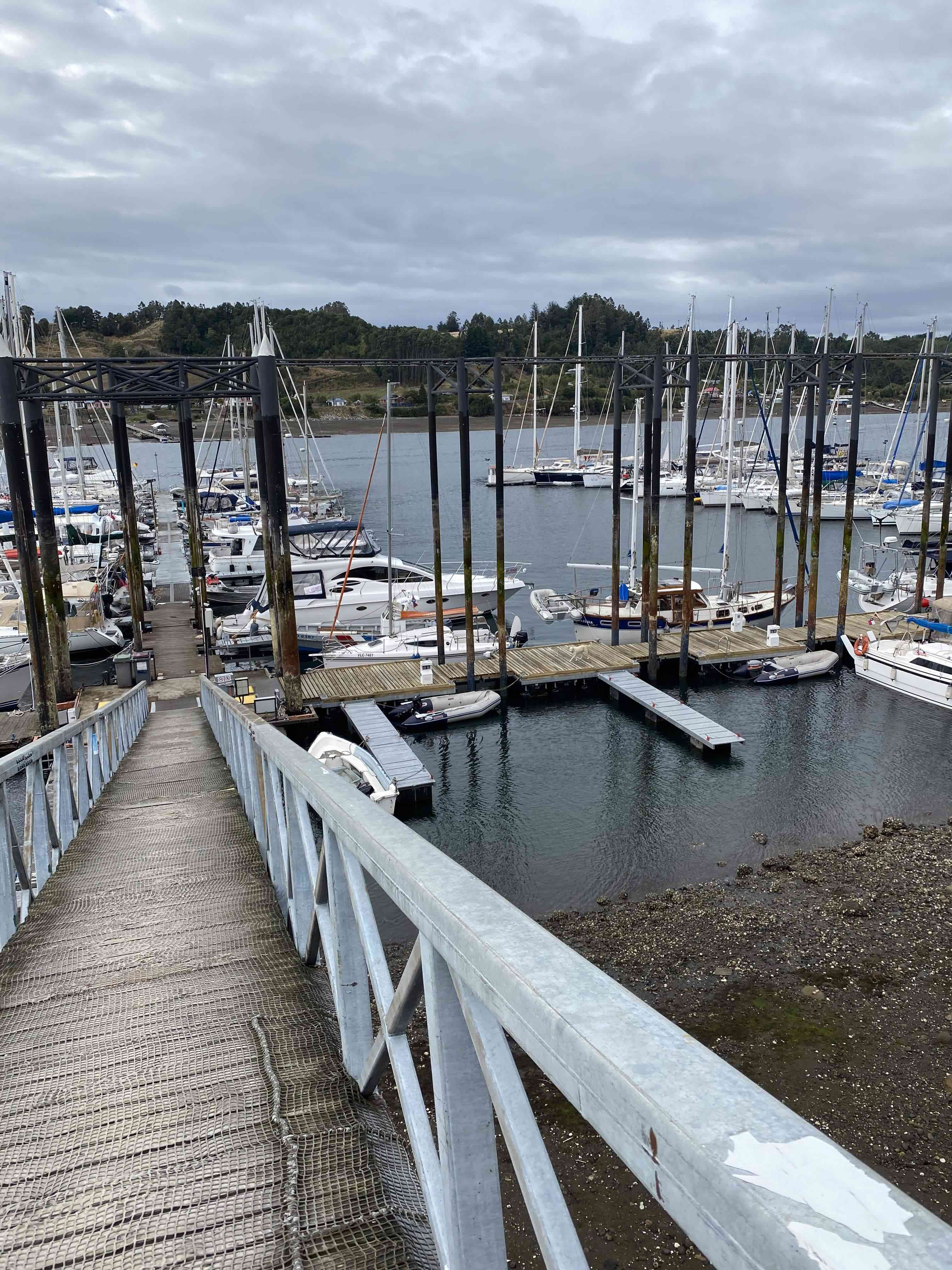
The marina in Puerto Montt
We had chosen to leave Gaia some 150 NM further north in Valdivia. This requires sailing through the Chacao channel separating the continent from Chiloe. Another stretch of water to be treated respectfully as the currents are strong and run against the west wind and swell from the Pacific. The sail north is then without further problems, except for being along a lee shore without any safe refuges.
The marina Estancilla is along the river leading to Valdivia in a very protected curve of the river. The facilities there are modest, but there is a possibility to lift a boat and staff is available to keep an eye on the few boats spending the Winter there. It is there that our sail around the southern end of the Americas ends. Gaia will stay there until November when we will meet her again for further cruises.




